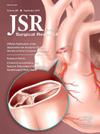小鼠肠道移植中现敏化加速抗体介导的排斥反应
IF 1.7
3区 医学
Q2 SURGERY
引用次数: 0
摘要
在器官移植中,供体特异性抗体(dsa)的存在是抗体介导的排斥反应(AMR)的一个危险因素。然而,由于缺乏合适的动物模型,AMR在肠道移植中的机制和临床特征仍然知之甚少。在本研究中,我们对已致敏的小鼠受体进行肠道移植,作为AMR的模型,以更好地了解这种现象如何导致移植物排斥反应。方法将供体B6小鼠皮肤移植到受体C3H小鼠背部。14天后,C3H小鼠接受来自B6小鼠的同种异体肠道移植。比较致敏小鼠和非致敏小鼠在不同时间点的循环dsa水平和肠道同种异体移植物特性。结果流式细胞术分析显示,随着时间的推移,受者的循环DSA水平升高。此外,在移植后第4天,致敏的受体比未致敏的小鼠表现出更严重的肠道移植排斥反应。虽然免疫染色显示移植后各组间CD4+和CD8+细胞的浸润数量无显著差异,但CD20+和CD68+细胞的浸润数量在现敏受体中明显较高。观察C3、C4在同种异体小肠移植后微血管内皮的沉积及移植后毛细血管炎的变化。结论成功建立了肠道移植环境下AMR的现敏化小鼠模型。我们的模型将在阐明AMR的潜在机制和探索管理这一现象以改善肠道移植结果的策略方面具有价值。本文章由计算机程序翻译,如有差异,请以英文原文为准。
Presensitization Accelerates Antibody-Mediated Rejection in Mouse Intestinal Transplantation
Introduction
The presence of donor-specific antibodies (DSAs) is a risk factor for antibody-mediated rejection (AMR) in the context of organ transplantation. However, the mechanisms and clinical characteristics of AMR in intestinal transplantation remain poorly understood, largely due to a lack of suitable animal models. In the present study, we performed intestinal transplantation in presensitized murine recipients as a model of AMR to better understand how this phenomenon contributes to graft rejection.
Methods
Skin from donor B6 mice was grafted onto the backs of recipient C3H mice. The presensitized C3H mice then received intestinal allografts from B6 mice 14 ds later. The presensitized and nonsensitized mice were compared in terms of their circulating DSAs levels and their intestinal allograft characteristics at various time points.
Results
Flow cytometric analysis showed that circulating DSA levels increased over time in the presensitized recipients. Moreover, the presensitized recipients exhibited more severe intestinal graft rejection at day 4 post-transplantation than the nonsensitized mice. Although immunostaining revealed no significant difference in the numbers of infiltrating CD4+ and CD8+ cells between the groups post-transplantation, the numbers of infiltrating CD20+ and CD68+ cells were significantly higher in the presensitized recipients. Furthermore, C3 and C4 deposition on the microvascular endothelium of intestinal allografts and capillaritis were observed after transplantation.
Conclusions
We successfully established a presensitized mouse model of AMR in the context of intestinal transplantation. Our model will be valuable in elucidating the mechanisms underlying AMR and exploring strategies for managing this phenomenon to improve the outcomes of intestinal transplantation.
求助全文
通过发布文献求助,成功后即可免费获取论文全文。
去求助
来源期刊
CiteScore
3.90
自引率
4.50%
发文量
627
审稿时长
138 days
期刊介绍:
The Journal of Surgical Research: Clinical and Laboratory Investigation publishes original articles concerned with clinical and laboratory investigations relevant to surgical practice and teaching. The journal emphasizes reports of clinical investigations or fundamental research bearing directly on surgical management that will be of general interest to a broad range of surgeons and surgical researchers. The articles presented need not have been the products of surgeons or of surgical laboratories.
The Journal of Surgical Research also features review articles and special articles relating to educational, research, or social issues of interest to the academic surgical community.

 求助内容:
求助内容: 应助结果提醒方式:
应助结果提醒方式:


